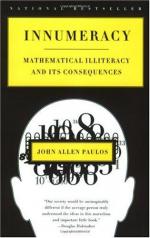
|
Introduction, Chapter 1 - Examples and Principles
1. What type of academic would most likely cringe over a misused word?
(a) Philatilist.
(b) Garanimal.
(c) Grammarian.
(d) Philologist.
2. What is one of the most common mistakes in math?
(a) Remembering the value of pi.
(b) Calculating diameter.
(c) Estimating probability.
(d) Solving word problems.
3. What news professional makes common errors in predictions?
(a) Meteorologist.
(b) Political reporter.
(c) Science analyst.
(d) Anchor.
4. What professional often makes major errors in calculating percentages?
(a) Doctor.
(b) Math teacher.
(c) Lawyer.
(d) Salesman.
5. What is the name of the expert in this chapter?
(a) Euclid.
(b) Pythagoras.
(c) Paulos.
(d) Newton.
6. What is another name for those not proficient in math?
(a) Uneducated.
(b) Morons.
(c) Innumerates.
(d) Illiterates.
7. What is the name of the mathematician who sees everything in numbers?
(a) Euclid.
(b) Ramanujan.
(c) Aristotle.
(d) Paulos.
8. The mathematician is from what country?
(a) India.
(b) Greece.
(c) US.
(d) Egypt.
9. What is one of the most misunderstood items according to Paulos?
(a) Multiplication tables.
(b) Large numbers.
(c) Calculators.
(d) Scientific notation.
10. What city is mentioned in one of the examples?
(a) Paris.
(b) London.
(c) New York.
(d) Munich.
(read all 180 Multiple Choice Questions and Answers)
|
This section contains 2,413 words (approx. 9 pages at 300 words per page) |

|




